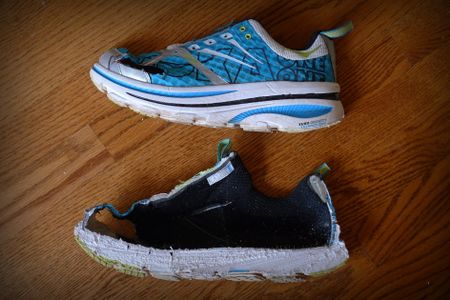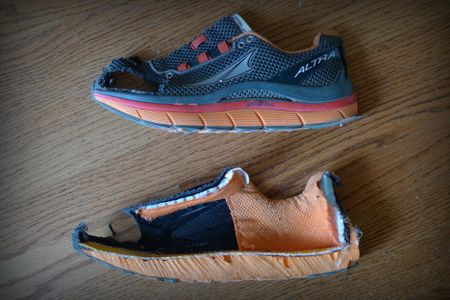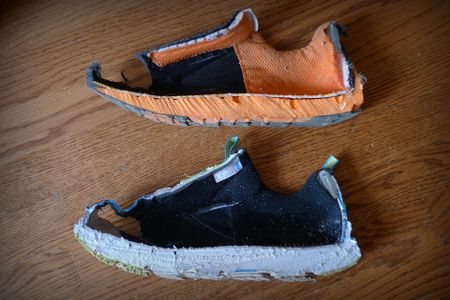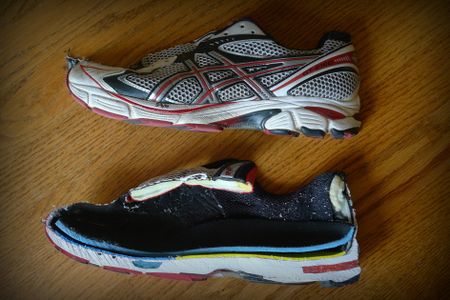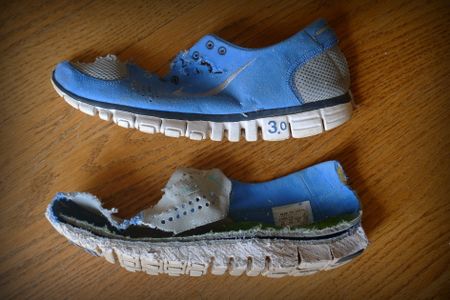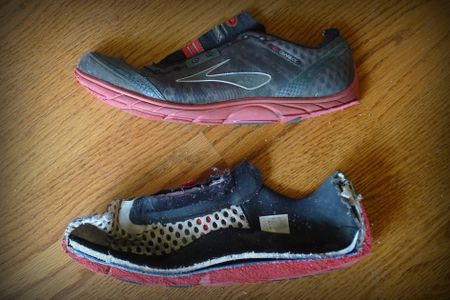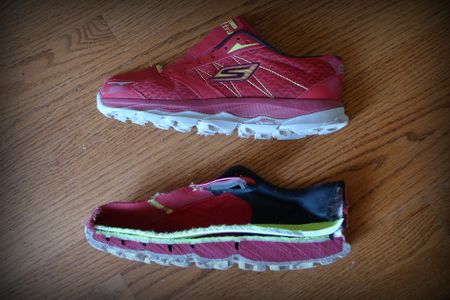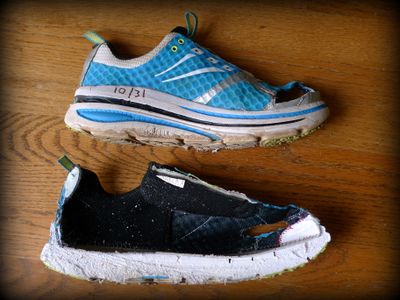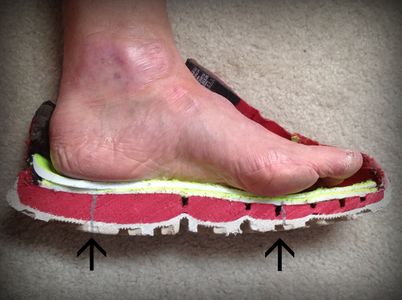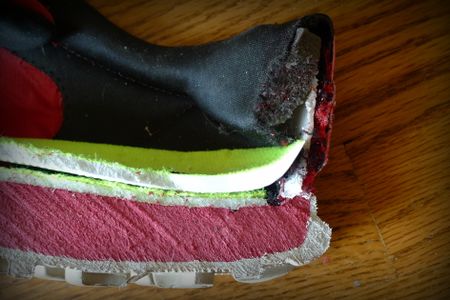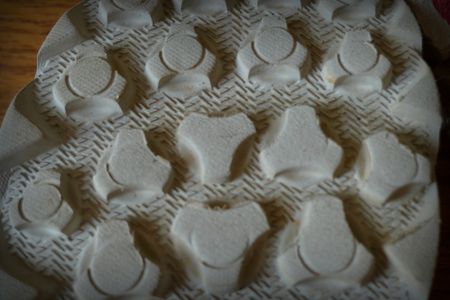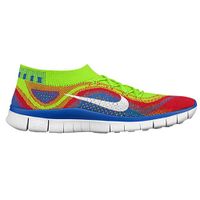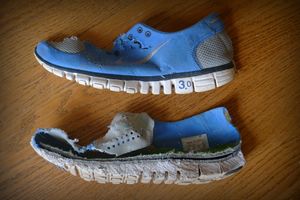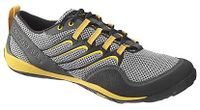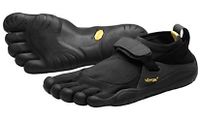Difference between revisions of "Shoes"
User:Fellrnr (User talk:Fellrnr | contribs) |
User:Fellrnr (User talk:Fellrnr | contribs) |
||
| Line 27: | Line 27: | ||
|[[File:OlympusSlice.JPG|none|thumb|x300px|Altra Olympus.]] | |[[File:OlympusSlice.JPG|none|thumb|x300px|Altra Olympus.]] | ||
|- valign="top" | |- valign="top" | ||
| + | |[[File:HokaOlympusSlice.JPG|none|thumb|x300px|A comparison between the Altra Olympus and Hokas.]] | ||
|[[File:GTSlice.JPG|none|thumb|x300px|Asics GT]] | |[[File:GTSlice.JPG|none|thumb|x300px|Asics GT]] | ||
| + | |- valign="top" | ||
|[[File:FreeSlice.JPG|none|thumb|x300px|Nike Free]] | |[[File:FreeSlice.JPG|none|thumb|x300px|Nike Free]] | ||
| + | |[[File:PureSlice.JPG|none|thumb|x300px|Brooks Pure]] | ||
|- valign="top" | |- valign="top" | ||
| − | |||
|[[File:HattoriSlice.JPG|none|thumb|x300px|Saucony Hattori]] | |[[File:HattoriSlice.JPG|none|thumb|x300px|Saucony Hattori]] | ||
| − | |||
|[[File:GoRunSlice.JPG|none|thumb|x300px|Skechers GO Run Ultra]] | |[[File:GoRunSlice.JPG|none|thumb|x300px|Skechers GO Run Ultra]] | ||
|} | |} | ||
| Line 42: | Line 43: | ||
* '''Transitional'''. These shoes are part way between categories, and so they tend to have a mix of characteristics. | * '''Transitional'''. These shoes are part way between categories, and so they tend to have a mix of characteristics. | ||
=Shoe Modifications= | =Shoe Modifications= | ||
| − | [[File:ModifiedShoes.JPG|none|thumb| | + | [[File:ModifiedShoes.JPG|none|thumb|250px|Clockwise from the top: [http://www.roadrunnersports.com/rrs/products/NIK1444/ Nike Free 3.0] (early version) cut open more than most to form a 'running sandal', [http://www.roadrunnersports.com/rrs/products/SCN984/ Saucony Hattori], [http://www.roadrunnersports.com/rrs/products/NBA1542/ NB Trail Minimus], [http://www.roadrunnersports.com/rrs/products/NIK1444/ Nike Free 3.0] and the non-minimalist [[Hoka Shoe Review|Hoka]].]] |
With the exception of the FiveFingers, the Mizuno Curoris and the Altras, I find that all shoes benefit from cutting open the toe box. This allows the toes to spread out as you toe off, creating more natural biomechanics and preventing toe blisters. | With the exception of the FiveFingers, the Mizuno Curoris and the Altras, I find that all shoes benefit from cutting open the toe box. This allows the toes to spread out as you toe off, creating more natural biomechanics and preventing toe blisters. | ||
=Summary Table= | =Summary Table= | ||
| Line 288: | Line 289: | ||
* New Balance Fresh Foam 980 has less of a drop than a traditional shoe, but it's too firm to be a true Minimax trainer. | * New Balance Fresh Foam 980 has less of a drop than a traditional shoe, but it's too firm to be a true Minimax trainer. | ||
==Altra Olympus== | ==Altra Olympus== | ||
| − | [[File:OlympusSlice.JPG|none|thumb|x300px| | + | {| class="wikitable" |
| − | This has rapidly become one of my favorite running shoes. It has the soft cushioning that is like the best of the Hoka range, combined with zero drop and a nice wide toe box. It's remarkably flexible given its cushioning, with an outsole that works well on the road. Like the Hokas, the cushioning means the shoe works well on rocky trails as well. Like other Altra shoes, the tongue area is wider than most shoes, reducing the pressure on the top of your foot. The weight is similar to a Hoka, but somehow feels lighter than a Hoka when I'm running. Like the Hokas, the midsole thins at the front and back to create a rocker effect, and this is a little more noticeable than the Hokas. I felt this worked well, though I've talked to runners who have found the rocker a little disconcerting. | + | |[[File:OlympusSlice.JPG|none|thumb|x300px|Altra Olympus.]] |
| + | |[[File:HokaOlympusSlice.JPG|none|thumb|x300px|A comparison between the Altra Olympus and Hokas. Notice the difference in the way the sole tapers towards the front of the shoe.]] | ||
| + | |} | ||
| + | This has rapidly become one of my favorite running shoes. It has the soft cushioning that is like the best of the Hoka range, combined with zero drop and a nice wide toe box. It's remarkably flexible given its cushioning, with an outsole that works well on the road. Like the Hokas, the cushioning means the shoe works well on rocky trails as well. Like other Altra shoes, the tongue area is wider than most shoes, reducing the pressure on the top of your foot. The weight is similar to a Hoka, but somehow feels lighter than a Hoka when I'm running. Like the Hokas, the midsole thins at the front and back to create a rocker effect, and this is a little more noticeable than the Hokas. I felt this worked well, though I've talked to runners who have found the rocker a little disconcerting. You can see the difference in the slice through the two shoes above, with the Hoka tapering in front of the ball of the foot and the Olympus starting to taper much further back. | ||
==Hokas== | ==Hokas== | ||
{{Main|Hoka Shoe Review}} | {{Main|Hoka Shoe Review}} | ||
| − | [[File:HokaHalfs.JPG|none|thumb| | + | [[File:HokaHalfs.JPG|none|thumb|x300px|The Hoka Bondi cut in half, showing the outside and inside views. You can see that the midsole foam is a lot higher on the outside than the inside.]] |
The Hoka shoes started the 'Minimum Drop, Maximum Cushioning' style of shoe and are still unique in their level of cushioning. The Hokas generally use extremely soft foam, with a wide base to improve stability. Their soles are thicker than most other shoes in this category, so they are quite heavy, though not as heavy as they look. Most of the Hokas do well on both asphalt and rocky trails, though the Mafate is designed for softer trails and does not like asphalt. The Hokas provide remarkable protection from rough trail surfaces, and the thick, soft soles mold themselves around stones to provide more grip on rocky trails than you'd expect. Other than the sole, the Hoka is a poor design, with a remarkably tight toe box and they are typically rather inflexible. | The Hoka shoes started the 'Minimum Drop, Maximum Cushioning' style of shoe and are still unique in their level of cushioning. The Hokas generally use extremely soft foam, with a wide base to improve stability. Their soles are thicker than most other shoes in this category, so they are quite heavy, though not as heavy as they look. Most of the Hokas do well on both asphalt and rocky trails, though the Mafate is designed for softer trails and does not like asphalt. The Hokas provide remarkable protection from rough trail surfaces, and the thick, soft soles mold themselves around stones to provide more grip on rocky trails than you'd expect. Other than the sole, the Hoka is a poor design, with a remarkably tight toe box and they are typically rather inflexible. | ||
* The Bondi is my favorite all round Hoka. The toe box is tight, even for a Hoka, but it's got the best balance of soft cushioning and reasonable weight. There is also the Bondi Speed/[http://www.zappos.com/hoka-one-one-bondi-evo-brilliant-blue-hi-rise-citrus Bondi Evo] that is quite similar, as is the Stinson. | * The Bondi is my favorite all round Hoka. The toe box is tight, even for a Hoka, but it's got the best balance of soft cushioning and reasonable weight. There is also the Bondi Speed/[http://www.zappos.com/hoka-one-one-bondi-evo-brilliant-blue-hi-rise-citrus Bondi Evo] that is quite similar, as is the Stinson. | ||
| Line 351: | Line 355: | ||
{| class="wikitable" | {| class="wikitable" | ||
|- valign="top" | |- valign="top" | ||
| − | |[[File:Free30v4.jpg|none|thumb|x200px|The (unmodified) Nike Free 3.0 Flynit.]] |[[File:FreeSlice.JPG|none|thumb|x200px|Nike Free]] | + | |[[File:Free30v4.jpg|none|thumb|x200px|The (unmodified) Nike Free 3.0 Flynit.]] |
| + | |[[File:FreeSlice.JPG|none|thumb|x200px|Nike Free]] | ||
|} | |} | ||
Nike Free are running shoes that are light weight, with very flexible soles. Even without modification, the Nike Free 3.0 is a good minimalist running shoe and a half way house to a zero drop shoe. There is no outer sole (the hard rubber that meets the road), just a robust midsole (the cushioning part). The midsole has deep groves cut into it to allow the shoe to flex more than is possible with a traditional shoe. There are lots of different models of Nike Free, but I would recommend using the [http://www.roadrunnersports.com/rrs/products/NIK1654/mens-nike-free-flyknit-30/ Free 3.0] flynit. (Most Frees have a number that indicates how flexible they are. The idea is that 10.0 would be a traditional shoe and 1.0 would be barefoot.) | Nike Free are running shoes that are light weight, with very flexible soles. Even without modification, the Nike Free 3.0 is a good minimalist running shoe and a half way house to a zero drop shoe. There is no outer sole (the hard rubber that meets the road), just a robust midsole (the cushioning part). The midsole has deep groves cut into it to allow the shoe to flex more than is possible with a traditional shoe. There are lots of different models of Nike Free, but I would recommend using the [http://www.roadrunnersports.com/rrs/products/NIK1654/mens-nike-free-flyknit-30/ Free 3.0] flynit. (Most Frees have a number that indicates how flexible they are. The idea is that 10.0 would be a traditional shoe and 1.0 would be barefoot.) | ||
| Line 373: | Line 378: | ||
<br style="clear: both" /> | <br style="clear: both" /> | ||
==Saucony Hattori== | ==Saucony Hattori== | ||
| − | [[File: | + | [[File:HattoriSlice.JPG|none|thumb|x300px|The [http://www.roadrunnersports.com/rrs/products/SCN984/ Hattori].]] |
The [http://www.roadrunnersports.com/rrs/products/SCN984/ Hattori] is a lightweight (4.4oz), zero drop shoe, but the sole is less flexible than the Nike Free and the sock style upper limits the fit. Zappos has the [http://www.runningwarehouse.com/descpageMRS-SHTLCM2.html Hattori LC] which has laces instead of a sock upper. | The [http://www.roadrunnersports.com/rrs/products/SCN984/ Hattori] is a lightweight (4.4oz), zero drop shoe, but the sole is less flexible than the Nike Free and the sock style upper limits the fit. Zappos has the [http://www.runningwarehouse.com/descpageMRS-SHTLCM2.html Hattori LC] which has laces instead of a sock upper. | ||
<br style="clear: both" /> | <br style="clear: both" /> | ||
Revision as of 06:39, 6 May 2014
These reviews cover what I consider to be the best running shoes. I believe that a running shoe should not interfere with the way you run, and therefore I favor shoes that have less of a raised heel and don't resist the way your foot moves as it lands. These shoes are either the thick soled 'minimal drop, maximum cushioning' (Minimax) or the thin soled minimalist style of shoe, with some transitional shoes that are closer to the traditional style. I have included a couple of traditional styled running shoes, mostly for comparison.Contents
- 1 Where to Buy
- 2 The best of the best
- 3 Shoe Categories
- 4 Shoe Characteristics
- 5 Shoe Dissection
- 6 What Style?
- 7 Shoe Modifications
- 8 Summary Table
- 9 Minimum Drop, Maximum Cushioning
- 10 Minimax Transitional
- 11 Traditional
- 12 Minimalist Transitional
- 13 Minimalist Shoes
- 14 Virtually Barefoot
- 15 The Outsole
- 16 The Newton
- 17 Adidas Boost Foam
1 Where to Buy
I generally recommend buying shoes from RoadRunnerSports.com as they allow you to run in the shoes and still return them for an exchange. It's hard to know how a shoe works for you until you've run in it for some distance. Another good option is Zappos.com which provides free shipping both ways, which allows you to spend time wearing the shoes around the house to see how they fit, though you can't run in them and return them.
2 The best of the best
My favorite shoes right now are the Altra Olympus and the Brooks Energy Boost. I use the Boost for faster paced running, and the Olympus for longer distances, though they are both good at either task. In many ways, the Olympus is a better Hoka, something I've been looking forward to for some time. My preferred minimalist shoes are the Merrell Glove series.
3 Shoe Categories
I've classified my shoe recommendations into several categories.
- Minimax (Minimum Drop, Maximum Cushioning). The minimal drop has been the hallmark of minimalist shoes, but these shoes also include lots of cushioning. At their best, these shoes can be like running barefoot on a cushioned track.
- Minimax Transitional. These are part way between what I consider a true Minimax shoe and a traditional shoe.
- Traditional. The classic running shoe has a high heel, normally about 10mm higher than the forefoot.
- Minimalist Transitional. These shoes are close to a traditional running shoe, but have reduced heel height and a thinner sole.
- Minimalist. If you want a little more protection and cushioning than the virtually barefoot options, but want to stay as close as you can, this is the next step up.
- Virtually Barefoot. These shoes are close to barefoot, but have some protection.
4 Shoe Characteristics
There are a number of characteristics
- Cushioning. Shoes vary in the mount of cushioning they provide. There is reasonable scientific evidence that higher levels of cushioning increase stresses on joints and have higher rates of injury. However, cushioning is also one way shoes provide protection from stones (the other is inflexibility). Cushioning can also reduce foot soreness on longer ultramarathons.
- Protection. Shoes provide protection from stones, uneven surfaces and abrasions. This protection can be in the form of a minimalist shoe's thin outsole, or the thick foam of a Minimax shoe.
- Fit. The importance of getting a shoe that fits correctly is often underestimated.
- Weight. The weight of a shoe makes a big difference in the energy cost of running. Even small changes in weight can make a big difference in how fast we run.
- Drop. The drop is difference in sole thickness between the forefoot and heel. Larger drops can interfere with natural running form, and may increase the probability of heel strike.
5 Shoe Dissection
I've cut many of my shoes in half to reveal their construction.
6 What Style?
There are pros and cons of each style of shoe, from Minimalist to Minimax.
- Minimalist/Virtually Barefoot. The benefit of these shoes is their light weight and lack of cushioning. Minimalist shoes are associated with a lower risk of injury than traditional shoes.
- Traditional. The biggest advantage of traditional shoes is the wide variety to choose from, making it far easier to find the right fit. However, there are concerns that traditional levels of cushioning may increase injury risk.
- Minimax. Minimax shoes offer lots of protection and comfort. They are great for longer ultramarathons where sore feet become a problem and for trail running where the cushioning makes it easier to ignore smaller rocks and stones. However, the extra cushioning may increase the risk of injury compared with minimalist shoes and the extra sole thickness increases the stress on your ankle.
- Transitional. These shoes are part way between categories, and so they tend to have a mix of characteristics.
7 Shoe Modifications
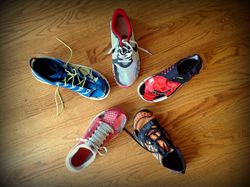
With the exception of the FiveFingers, the Mizuno Curoris and the Altras, I find that all shoes benefit from cutting open the toe box. This allows the toes to spread out as you toe off, creating more natural biomechanics and preventing toe blisters.
8 Summary Table
| Category | Shoe | Weight | Drop | Sole thickness | Subjective cushioning | Use | Notes |
|---|---|---|---|---|---|---|---|
| Minimax | Altra Olympus | 10.0oz | Zero | 36mm | 10 | Road/Rocky Trail | Top pick |
| Hoka Bondi 3 | 11.1oz | 5mm | 30/35mm | 9 | Road/Rocky Trail | ||
| Hoka Mafate 3 | 15.1oz | 6mm | 35/41mm | 5 | Muddy Trail | ||
| Hoka Conquest | 11.9oz | 4mm | 28/34mm | 6 | Road/Rocky Trail | ||
| Hoka Stinson | 11.8oz | 6mm | 32/38mm | 7 | Road/Rocky Trail | ||
| Hoka Rapa Nui 2 Tarmac | 10.7oz | 4mm | 26/30mm | 3 | Road | Lighter for a Hoka but overly firm | |
| Minimax Transitional | Skechers GOrun Ultra | 9.5oz | 14 mm (10mm without insole) | 26/40mm (24/34mm without insole) | 9.5 (heel) | Road | |
| Adidas Energy Boost | 9.3 | 9mm | 17/26mm | 8 | Road | A remarkable shoe with new midsole technology | |
| Mizuno Cursoris | 6.8oz | Zero | 18mm | 3 | Road | Soft, light and comfortable | |
| Altra Torin | 9.0oz | Zero | 20mm | 3.5 | Road | ||
| Saucony Virrata | 6.7oz | Zero | 17mm | 3 | Road | ||
| New Balance Fresh Foam 980 | 9.1oz | 4mm | 21/25mm | 4 | Road | ||
| Traditional | Brooks Transcend | 11.8oz | 8mm | 22/30mm | Road | ||
| Asics GT 2000 | 10.9oz | 9mm | 20/29mm | Road | A shoe that almost defines 'traditional' | ||
| Minimalist Transitional | Nike Free 3.0 Flyknit | 7.1oz | 4mm | Road | Highly flexible | ||
| Mizuno Wave Universe | 3.8oz | 4mm | Road | Lightweight | |||
| Inov-8 F-Lite 195 | 6.8oz | 3mm | Road/Trail | ||||
| Inov-8 X-Talon 190 | 6.7oz | 3mm | Muddy Trail | Aggressive tread | |||
| NB Minimus | 6-8oz | 4mm | Road/Trail | ||||
| Saucony Kinvara | 7.7oz | 4mm | Road | ||||
| Minimalist | Modified Nike Free | Varies – 5 to 6oz | Zero | Road | |||
| Saucony Hattori | 4.4oz | Zero | 15mm | Road | No laces | ||
| NB Road Minimus | 6.4oz | Zero | Road | ||||
| Merrell Trail Glove | 6.2oz | Zero | 10mm | Road/Trail | |||
| Merrell Road Glove | 6.5oz | Zero | 11mm | Road | |||
| Virtually barefoot | Vibram FiveFingers | 5-10oz | Zero | Road/Trail | |||
| Vivobarefoot One M | 7oz | Zero | Road |
9 Minimum Drop, Maximum Cushioning
This category of shoes was started by Hoka and followed by several others. Only the Olympus matches the Hokas for their oversized soles made of extra soft foam. There are a number of other shoes that come close, and I've put them under the 'Minimax Transitional' category. Here's a summary list of all the Minimax shoes:
- The best shoe in this category is the Olympus, capturing the best of the Hoka approach and improving on it.
- The Hoka has greater cushioning and protection, but is heaver and pricy.
- Skechers has made a valiant attempt with their GOrun Ultra, producing a Hoka like shoe for less than half the price. Its major problem is the drop, as the heel is much higher than the forefoot.
- Adidas Energy Boost. This is built like a traditional shoe, but the new midsole material makes it seem much better cushioned that you'd expect.
- The Cursoris is soft, light and seems faster than most other shoes in this category, but has less protection and longevity.
- The Torin is zero drop, and has more cushioning than a minimalist shoe, but the foam is quite firm.
- The Virrata is nearly as good as the Torin, but cheaper.
- New Balance Fresh Foam 980 has less of a drop than a traditional shoe, but it's too firm to be a true Minimax trainer.
9.1 Altra Olympus
This has rapidly become one of my favorite running shoes. It has the soft cushioning that is like the best of the Hoka range, combined with zero drop and a nice wide toe box. It's remarkably flexible given its cushioning, with an outsole that works well on the road. Like the Hokas, the cushioning means the shoe works well on rocky trails as well. Like other Altra shoes, the tongue area is wider than most shoes, reducing the pressure on the top of your foot. The weight is similar to a Hoka, but somehow feels lighter than a Hoka when I'm running. Like the Hokas, the midsole thins at the front and back to create a rocker effect, and this is a little more noticeable than the Hokas. I felt this worked well, though I've talked to runners who have found the rocker a little disconcerting. You can see the difference in the slice through the two shoes above, with the Hoka tapering in front of the ball of the foot and the Olympus starting to taper much further back.
9.2 Hokas
Main article: Hoka Shoe Review
The Hoka shoes started the 'Minimum Drop, Maximum Cushioning' style of shoe and are still unique in their level of cushioning. The Hokas generally use extremely soft foam, with a wide base to improve stability. Their soles are thicker than most other shoes in this category, so they are quite heavy, though not as heavy as they look. Most of the Hokas do well on both asphalt and rocky trails, though the Mafate is designed for softer trails and does not like asphalt. The Hokas provide remarkable protection from rough trail surfaces, and the thick, soft soles mold themselves around stones to provide more grip on rocky trails than you'd expect. Other than the sole, the Hoka is a poor design, with a remarkably tight toe box and they are typically rather inflexible.
- The Bondi is my favorite all round Hoka. The toe box is tight, even for a Hoka, but it's got the best balance of soft cushioning and reasonable weight. There is also the Bondi Speed/Bondi Evo that is quite similar, as is the Stinson.
- The Mafate is the thickest and heaviest of the Hokas, and it firmer than you might expect. However, it has the most aggressive outsole for use in muddy trails.
- The Conquest is a little lighter than the Bondi, but is not as softly cushioned. The Conquest is using a newer foam (RMAT) that they claim is longer lasting. I've not worn out my Conquest shoes yet, so I can't comment on the longevity, but don't expect the same softness as the Bondi.
- The Rapa Nui 2 is lighter, thinner and a little cheaper than the other Hokas, but I found it far too firm to be considered 'maximum cushioning'. In fact, the Adidas Energy Boost feels far more cushioned to me, though it does not offer the same level of protection from stones or uneven surfaces.
10 Minimax Transitional
These shoes are not quite 'minimum drop, maximum cushioning' of the Minimax category, but they're thicker than most shoes and tend to have less drop.
10.1 Skechers GOrun Ultra
Is this a Hoka for only $80? Sadly not, but it's closer than you might expect, though the cost per mile probably works out more than the longer lasting Hokas.
- Cushioning. The GOrun Ultra is massively cushioned in the heel; it's as thick as the thicker Hokas, but softer. However, the forefoot is far thinner.
- Protection. The GOrun offers little protection compared with other Minimax shoes. This is partly because the forefoot is relatively thin and partly because of the large foam lugs. If you hit a stone between the lugs the forefoot is only 22mm (with insole). If the stone hits on the gap in the red foam, you'd only have about 17mm of remarkably soft foam. Ouch.
- Drop. The drop with the insole is 14mm, making it worse than a traditional running shoe. If you take the insole out, the drop is reduced to 10mm, which is not quite as bad, though slightly more than a traditional shoe. However, if you look at the picture above, you'll notice the cut outs in the red foam around the forefoot, which makes the drop seem worse as the forefoot is softer and more compressible.
- Note that the measurements published by Skechers indicate the drop is 8mm with the insole and 4mm without the insole. I've also seen the measurements of 23/27mm sole height quoted by third parties. However, an independent measurement is 27/41mm with the insole, 25/35mm without, which close to my measurement. I took my measurement from under the ball and heel of the foot using the slice seen above.
- Medial post. The construction of the sole is a little odd, becoming thicker just in front and to the inside of your heel. This creates what is sometimes called a medial post, which is intended to resist the natural roll of your foot as it lands.
- Feel. I found the combination of the medial post and the large drop rather disconcerting, and while the heel is nicely cushioned, the forefoot feels rather poor. I've run a few miles with a GOrun Ultra on one foot and a Hoka Bondi on the other (don't do that at home), and the shoes feel superficially similar.
- Heel counter. The heel counter on this shoe is rather different to other shoes, putting almost no pressure on the Achilles' tendon. Instead the heel counter presses on the back of the heel bone, which feels rather odd initially, and when running faster it felt like the GORun Ultras would come off. However, it's possible that this shoe may work better if you are having Achilles' Tendon issues.
- Wear. Shoes that lack the hard rubber outsole layer always wear more quickly, but the GORun Ultra's have lugs that wear even quicker than others. If found noticeable wear after only 130 miles.
- Injury. I found that I started to develop knee pain during the time I was trying out these shoes, even though I was only running short distances in them. The knee pain disappeared after I ceased using the GORun ultras. This could be coincidence of course, but it does concern me.
The GOrun has most of the softness and comfort of the Hoka at a far lower purchase price. However, I have some concerns with amount of drop and the rapid wear that undermines the cost advantage.
10.2 Adidas Energy Boost

The Adidas Energy Boost has a new material in the midsole (see 'Adidas Boost Foam' below) which changes how this shoe feels. The Boost does not really count as a minimalist shoe or a Minimax shoe, as it has a mainstream design, with the typical raised heel and cushioning that is no thicker than normal. However, because the boost foam works so well, it works far better than you'd expect.
- As a Minimax. Though it's not as thick as a Minimax shoe, it's soft cushioning makes it feel much thicker than it actually is, and it's a lot softer than something like the Brooks Transcend. While it does not offer the protection of a Hoka, it does offer a lot of the feeling of soft cushioning.
- As a minimalist. If you take out the insole, you also lose quite a bit of the higher heel and have something that's close to a minimalist shoe. I estimate that the insole is about 3mm in the forefoot and 5mm at the heel. Without that extra, the shoe is a 7mm drop (14mm/21mm). The shoe is light weight, and the new foam is pleasant under foot, combining a forefoot that had good ground feel with reasonable protection.
The Energy Boost is immediately comfortable, with a light, flexible upper with no noticeable seams. I'm thankfully Adidas has used a traditional tongue and laces, rather than a sock style upper or Velcro fastening. And while the sole has the traditional raised heel, there is none of the multi-density foam or other intrusions that are so common. I think a lot of people will buy the boost because of its immediate comfort, but stay with it for its extraordinary characteristics.
10.3 Mizuno Cursoris
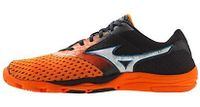
The Cursoris is a light shoe with a soft sole, almost as soft as the Hokas, but only half the thickness so overall the cushioning is less. The Cursoris is clearly a road shoe, with little protection from stones, and no outsole grip. The toe box is the biggest and best designed of any shoe I've tried, even better than the Altra's. The upper is soft, which some people find strange and can result in them being over tightened. Once you get used to the feeling that they're barely there, they stay in place well. However, they wear as quickly as you might expect, so the cost per mile is quite high.
10.4 Altra Torin
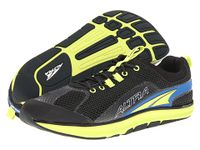
The Torin is superficially similar to the Cursoris, with a similar shape and sole. However the Torin uses a firmer foam, so it feels quite different. Like the Cursoris, the Torin is a road shoe, with no outsole grip. While the Torin has a better toe box than nearly every other shoe, it's not as good as the Cursoris. The Torin has lots of space beside the big toe, but the smallest toe is more cramped and the roof of the toe box is low. There are a lot of complaints about the lacing on the Torin not coming up the foot high enough so it feels like there is too much movement around the ankle. While this feels a little odd, I did not notice any actual problems from this unless the laces are loose. The firmer foam will provide more protection from stones and uneven surfaces than the Cursoris, but it will not provide the level of soft cushioning.
10.5 Saucony Virrata
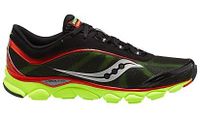
The Virrata feels almost identical to the Torin, and when I wore one on either foot I found I could feel only minor differences in the sole. The toe box however is like most other shoes and is way too small, but cutting the toe box open mostly solves the problem. The Virrata is a nice shoe, and while not as good as the other shoes in this category, it's quite a bit cheaper than most of the others.
10.6 New Balance Fresh Foam 980
The New Balance Fresh Foam 980 has less of a drop than a traditional running shoe, but it does not have the same soft cushioning of a Minimax shoe. This is not a bad shoe for someone looking for slightly less of a drop than a traditional shoe while avoiding the thin sole of a minimalist shoe.
11 Traditional
I've included a couple of traditional running shoes, mostly for comparison.
11.1 Asics
The Asics GT 2000 has been around for many years in one form or another, a reflection of its popularity. The GT 2000 series could be considered one of the best "average" running shoes, and it is often used as the starting point when a new runner is looking for their first shoes. The original GT 2000 was introduced back in 1995 and has been updated many times. (They did add 10 to the number every year until the 2170, then reverted to 2000 and added a version number.) So I've included the GT 2000 here partly as a good starting point for those looking for a traditional running shoe and partly as the shoe that is probably closest to the average running shoe.
11.2 Brooks Transcend
The Brooks Transcend is included in this section, not because it is one of the best running shoes, but because it is sometimes considered a "maximum cushioning" shoe, and Brooks claim it is "the Ultimate Plush Ride". However, when compared with a traditional running shoes, the transcend is only 1-2 mm thicker, and the foam is too firm to be considered a Minimax shoe.
12 Minimalist Transitional
These are not zero drop, but they have less drop than a traditional shoe, are lightweight and flexible.
12.1 Nike Free
Nike Free are running shoes that are light weight, with very flexible soles. Even without modification, the Nike Free 3.0 is a good minimalist running shoe and a half way house to a zero drop shoe. There is no outer sole (the hard rubber that meets the road), just a robust midsole (the cushioning part). The midsole has deep groves cut into it to allow the shoe to flex more than is possible with a traditional shoe. There are lots of different models of Nike Free, but I would recommend using the Free 3.0 flynit. (Most Frees have a number that indicates how flexible they are. The idea is that 10.0 would be a traditional shoe and 1.0 would be barefoot.)
12.2 Mizuno Wave Universe

The Mizuno Wave Universe is a racing flat that is surprisingly comfortable and remarkably light weight. I ran in these before I discovered the Nike Free and got on well with them.
12.3 Inov-8 Trail Shoes
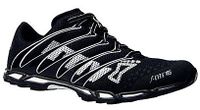
Inov-8 produces a wide range of minimalist trail shoes. Of particular note are their X-Talon 190 for muddy conditions and their F-Lite 195 for rocky conditions. I've used a number of Inov-8 shoes and I highly recommend them, especially for the more gnarly and technical trails.
12.4 Saucony Kinvara
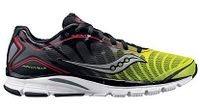
The Saucony Kinvara is an evolution of the traditional running shoe towards a minimalist design. It looks like a traditional running shoe, but lowers the heel and reduces the weight. To me, this shoe is on the boundary between minimalist and traditional, though others might include some of the Brooks Pure range as minimalist.
13 Minimalist Shoes
These are zero drop shoes with minimal cushioning, but they are not virtually barefoot.
13.1 Modified Nike Free
With modification, the Nike Free 3.0 can provide a minimalist shoe with just enough cushioning to provide good protection. I prefer the Modified Nike Free to Vibram FiveFingers, as the small amount of extra padding protects my feet much better, while the flexibility gives a surprisingly similar experience. The longevity of the Modified Nike Free is good, lasting for 2,000+ miles.
13.2 Saucony Hattori

The Hattori is a lightweight (4.4oz), zero drop shoe, but the sole is less flexible than the Nike Free and the sock style upper limits the fit. Zappos has the Hattori LC which has laces instead of a sock upper.
13.3 New Balance Minimus
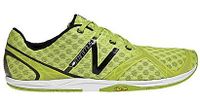
The Minimus is a range of minimal shoes from New Balance that has created a lot of interest in the minimalist running community as the trail shoe was designed with the help of ultrarunner Anton Krupicka. There is a Trail Minimus and a Road Minimus which share similar names, but are rather different shoes. The Trail Minimus worked well for me on mild trails, but I prefer the Modified Nike Free to the road version.
13.4 Merrell Gloves
Merrell sells a trail glove and a road glove. The trail glove has a thin forefoot plate and both are zero drop.
14 Virtually Barefoot
If you want to get as close to barefoot as you can, the best option by far is the FiveFingers. However it can be tricky to get them to fit right if you have an unusual shaped foot, in which case consider the Vivo Barefoot.
14.1 Vibram FiveFingers
Vibram FiveFingers are popular Minimalist Running shoes. They are a thin sole combined with just enough material to hold them to your foot and a separate pocket for each toe, hence the name FiveFingers. They were originally created for boating, not running, but they have become hugely popular. The FiveFinger soles generally last a long time, but the uppers can be prone to tearing. Getting FiveFingers that fit can be tricky depending on the shape of your foot, so they don't work for everyone. The Bilika LS are slightly wider and have laces, which improves the fit for some.
14.2 Vivobarefoot

Terra Plana make a range of thin soled shoes under the 'Vivo Barefoot' name, such as their Vivobarefoot One M , with a flexible but tough sole. I'd also strongly recommend the Vivobarefoot Ra, which is close to a dress shoe, but remarkably comfortable. I got mine for a wedding and new wear them regularly.
15 The Outsole
To achieve a light weight with maximum cushioning, many shoes don't use a hard rubber outsole over the softer midsole. This can result in uneven wear patterns when the midsole erode away from around the patches of outsole. In the image below, the red arrows mark the soft midsole and the blue arrows mark the hard outsole, with the green arrow indicating an intermediate toughness material.
16 The Newton
Newton shoes focus on forefoot running by adding extra height to the forefoot of the shoe. I purchased a pair thinking they would move me closer to barefoot running. The result of the high forefoot is an unstable shoe. I believe the Newton takes a bad idea (the traditional running shoe) and makes it worse. You can get a better alternative to the Newton just by hacking the sole heel off an old pair of running shoes. (The Newton is mentioned in The 4 Hour Body as a shoe that is correlated with injuries.)
17 Adidas Boost Foam
The Adidas boost uses a new type of foam in the sole that has more bounce and is more resilient. Adidas demonstrates this extra bounce by dropping a steel ball on their new foam and EVA, the industry standard foam. Because of the extra energy return in their new foam the ball will bounce much higher than on EVA. However, when we run our feet do not bounce off the ground, but have a short period of sustained contact, often called the 'stance phase'. So when your foot lands, it seems that the boost foam would return the landing shock back up your leg rather than absorbing it, which is less than ideal. It would be good to see a study that looks at how the boost foam changes the stresses on knees and hips compared with a standard running shoe. Regardless of how the bounce impacts your running, the increased lifespan of the new foam is appealing. Having a shoe that lasts longer is obviously good, but Adidas also claim that the new foam is more consistent through most of its lifespan, rather than gradually decaying in the way EVA does. Adidas also claims that their new foam does not change characteristics in extreme temperatures like EVA does.
